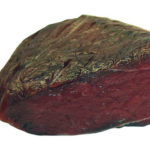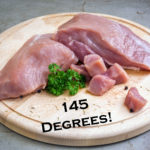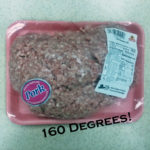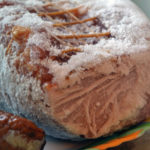As a personal chef, I take a lot of pride in making sure I am cooking with the freshest, good quality ingredients. On the flipside, I don’t want to waste ingredients that are fresh, but that I mistakenly assume are not.
 Over the years, I have done a lot of research to allow me to spot what’s fresh and what’s not, causing me to be the person that all my family and friends come to for answers to their food questions. “How do I know if an avocado is ready to be eaten?” “I made chili a week ago, do you think it’s safe to eat tonight?” I’m not complaining that they come to me with these questions, it just really makes me laugh sometimes. Since I have become the go-to person among my family and friends, I thought I would share some of this knowledge with you all. Most of my friends’ and family’s questions tend to be about meat, so I thought I would focus on debunking meat myths this week.
Over the years, I have done a lot of research to allow me to spot what’s fresh and what’s not, causing me to be the person that all my family and friends come to for answers to their food questions. “How do I know if an avocado is ready to be eaten?” “I made chili a week ago, do you think it’s safe to eat tonight?” I’m not complaining that they come to me with these questions, it just really makes me laugh sometimes. Since I have become the go-to person among my family and friends, I thought I would share some of this knowledge with you all. Most of my friends’ and family’s questions tend to be about meat, so I thought I would focus on debunking meat myths this week.
Brown Spots on Red Meat
 Pop Quiz! Do brown spots on your steak or ground beef mean it’s spoiled? If you answered “yes”, you are WRONG! Though most people assume that brown spots must mean that meat is bad, it’s actually just a sign of oxidation, resulting in a brown color. It’s fine to cook and eat…as long as it’s not slimy or smelly. Which leads us to:
Pop Quiz! Do brown spots on your steak or ground beef mean it’s spoiled? If you answered “yes”, you are WRONG! Though most people assume that brown spots must mean that meat is bad, it’s actually just a sign of oxidation, resulting in a brown color. It’s fine to cook and eat…as long as it’s not slimy or smelly. Which leads us to:
The Nose Knows Best
I know that old saying is “go with your gut”, but when it comes to all meats, you should go with your nose! The NUMBER ONE indicator of spoiled meat is an “off” smell. Second to that is texture. Anything that feels slimy, sticky, or tacky is an indication that it could be spoiled.
Cooking Pork
 I always recommend using a meat thermometer when cooking with any meat, but especially when cooking pork, as it overcooks easily. The myth here is that all pork needs to be cooked until it reaches an internal temperature of 160 degrees. The USDA changed the safe cooking temperatures for most cuts of pork about seven years ago.
I always recommend using a meat thermometer when cooking with any meat, but especially when cooking pork, as it overcooks easily. The myth here is that all pork needs to be cooked until it reaches an internal temperature of 160 degrees. The USDA changed the safe cooking temperatures for most cuts of pork about seven years ago.  When cooking ribs, tenderloin, loin roasts, chops and cutlets, regardless of your cooking method (braising, stewing, roasting, broiling, grilling or cooking in a skillet on the stove top, cook the pork until it reaches 145 degrees and then let it rest for at least three minutes. No change in recommendation for ground pork and patties, however, they still should be cooked until they reach 160 degrees.
When cooking ribs, tenderloin, loin roasts, chops and cutlets, regardless of your cooking method (braising, stewing, roasting, broiling, grilling or cooking in a skillet on the stove top, cook the pork until it reaches 145 degrees and then let it rest for at least three minutes. No change in recommendation for ground pork and patties, however, they still should be cooked until they reach 160 degrees.
Feeling the (freezer) Burn
 There are many myths about this one. First, it is a common belief that foods with freezer burn are spoiled. This is not true, although flavor, texture and nutritional value may take a hit. It is also a common belief that potentially toxic chemicals found in freezers are what cause freezer burn. Luckily, this is not true either. Freezer burn is simply the result of water molecules expanding within the food items, turning into ice crystals. The “burned” areas may be dried out and tasteless, and it’s probably best to cut them away before cooking. One of my tried and true tricks to prevent freezer burn: cover/wrap food with Press’n Seal. If you are a client of mine and choose to have some of your meals stored in the freezer, then you have surely seen my use of Press’n Seal. I might get into a physical altercation with the stuff EVERY. SINGLE. TIME. I use it, but it’s worth it. Most often, I cover the meals with the Press’n Seal before covering with a lid. If you’re not storing your food properly, it is very likely that it will form freezer burn.
There are many myths about this one. First, it is a common belief that foods with freezer burn are spoiled. This is not true, although flavor, texture and nutritional value may take a hit. It is also a common belief that potentially toxic chemicals found in freezers are what cause freezer burn. Luckily, this is not true either. Freezer burn is simply the result of water molecules expanding within the food items, turning into ice crystals. The “burned” areas may be dried out and tasteless, and it’s probably best to cut them away before cooking. One of my tried and true tricks to prevent freezer burn: cover/wrap food with Press’n Seal. If you are a client of mine and choose to have some of your meals stored in the freezer, then you have surely seen my use of Press’n Seal. I might get into a physical altercation with the stuff EVERY. SINGLE. TIME. I use it, but it’s worth it. Most often, I cover the meals with the Press’n Seal before covering with a lid. If you’re not storing your food properly, it is very likely that it will form freezer burn.
So what’s the takeaway here? Whether you’re putting it in the refrigerator or freezer, store your meat so that you keep out air and moisture…and don’t overcook your pork! 🙂
Sources:
https://www.glad.com/food-storage/plastic-wrap/press-n-seal/


Great stuff thx Chef Annie !
You are welcome, please continue to check in for more informative info 🙂